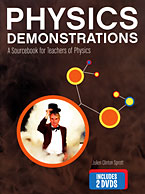
 |
The book has chapters on motion, heat, sound, electricity, magnetism, and light; each contains sections labeled by demonstration or concept, with some sections containing several individual demonstrations. Many of the classic physics demonstration books contain a lot of descriptive material concerning demonstrations and their construction. What sets Sprott's book apart is additional material that is crucial to making quality presentations that are real teaching and learning experiences. Sprott uses lots of colorful pictures to discuss the apparatus for each demonstration, the physical basis for the demonstration, what the demonstration does and how it explains the concept of interest, and even a few of his favorite gags. He discusses safety considerations and highlights specific possible dangers.
Sprott's book should be placed in the libraries of all college physics departments and would be useful for many high-school physics programs. I would like to see a section specifically on demonstrations in modern physics -- quantum mechanics, atomic and nuclear physics, for example. Yet scattered throughout the book's other topics are many nice modern-physics demonstrations. Several detailed presentations on chaos and related topics are included, which makes Physics Demonstrations a significant update compared with other classic demonstration books such as Physics Demonstration Experiments (Ronald Press, 1970), edited by Harry Meiners; Physics Demonstration Experiments at William Jewell College (William Jewell College, 1971) by Wallace Hilton; and A Demonstration Handbook for Physics (American Association of Physics Teachers, 1972) by George Freier and Frances Anderson.
Sprott offers some unusual and sophisticated demonstrations that often provoke discussion among physicists. He has something for everyone -- from the novice physics lecturer to the experienced physicist who is looking for new ways to excite his or her students. Even after doing classroom demonstrations, including the "Physics is Phun" program, for more than 30 years at my university, I continue to get new ideas from Sprott.
A thorough bibliography is included at the end of the book. For those new to the physics-demonstration business, Sprott provides appendices of selected vendors of equipment and audiovisual and computer-based materials. I found the index helpful, too. In the accompanying DVDs, Sprott demonstrates with his unique style the experiments discussed in his book. The videos are of high quality; the camera work is excellent, allowing the viewer to see in detail exactly how the equipment works and how Sprott uses the demonstrations to teach physics. I found his interviews with his student subjects particularly interesting: His very personable approach and his effective use of humor make it easy to see why his programs have become so popular. Aspiring physics demonstrators should find these videos very helpful.
As with any book of this magnitude, a few typographical errors exist, but they do not detract from the book's pedagogical value. Sprott does an admirable job of simply explaining complex demonstrations. However, one error often found in many textbooks may merit further discussion: It is my understanding that the Coanda effect more accurately explains airfoil lift and the ball levitating on an air jet than does the Bernoulli effect.
Physics Demonstrations and its accompanying DVDs are excellent reference materials for beginning physics teachers, experienced lecture demonstrators, and interested students. I thoroughly enjoyed reading the book and watching the videos; they will assume an honored place in my library, among my collection of "The Wonders of Physics" tapes and kit. I hope many of my colleagues will also take the opportunity to learn from Sprott.